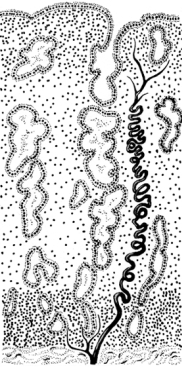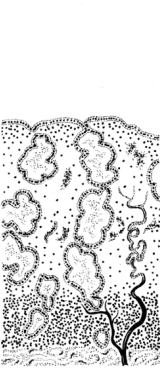|
Day 4: Early proliferative or follicular phase. Following menstruation, the endometrium is reconstructed by the active proliferation of the surviving basal glandular epithelial cells and by the multiplication of fibrocytes. The spiral arterioles also initiate their reconstruction and growth. |
Day 14: End of follicular phase and beginning of secretory or luteal phase. This is at the time of ovulation. The endometrium has considerably increased in thickness. The glands are long and wavy and have narrow lumina. Their epithelial cells show early signs of secretory activity. The spiral arterioles are now well developped in the superficial zone. |
Day 20: Mid-secretory or luteal phase. The superficial zone reaches its maximal thickness due mainly to the accumulation of edematous fluid between the stromal cells. The coiled uterine glands have a wide lumen. Their epithelial cells stop dividing and show clear signs of secretory activity. The spiral arterioles and venules reach their maximal sizes. |
Day 25: End of secretory or luteal phase. The endometrium decreases in thickness due to the loss of edematous fluid in the superficial zone. The spiral arterioles undergo spastic contractions producing periodic ischemia of the mucosa that damages the capillaries and provokes the formation of blood lakes in the superficial zone. |
Days 28–4: Menstrual phase. Consecutive to a sustained ischemia, the superficial zone of the endometrium breaks down. The stroma and enclosed blood plus the superficial parts of the glands and blood vessels are sloughed off. The basal zone of stroma and the embedded portions of the uterine glands are preserved and serve in the regeneration of the endometrium during the following endometrial cycle. |




